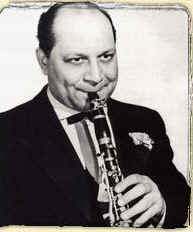Barney
Bigard
Barney
Bigard (Albany Leon) was born in Villere Street, New Orleans on March 3rd 1906.
Not at first a keen musician, Barney was encouraged by his musical family to
begin learning the clarinet at age 7. His teachers were Lorenzo Tio and
Pappa Tio, probably the best in New Orleans at that
time.

